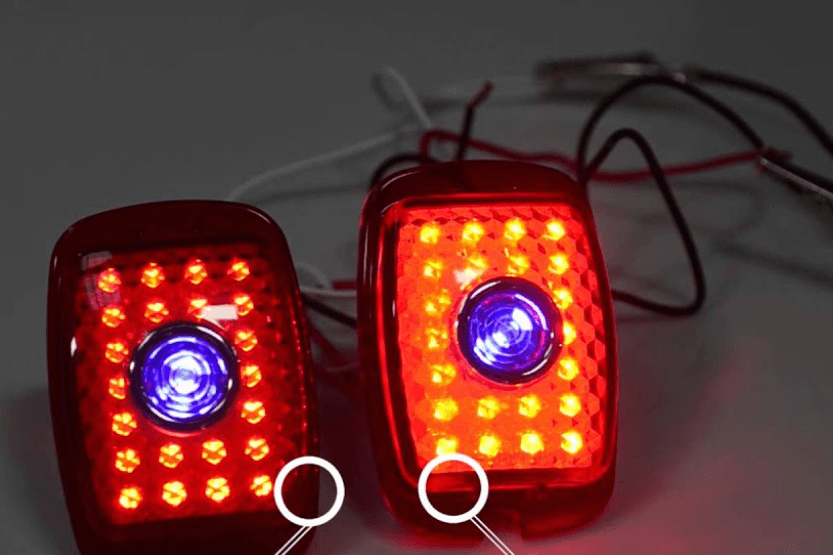Blue dot tail lights have been a popular automotive accessory for decades. These unique lights are instantly recognizable by their blue dot in the center of the tail light lens. But what is the history behind these distinctive lights?
Blue dot tail lights first appeared in the 1940s and 1950s, during the heyday of hot rodding and custom cars. The blue dot was added to the tail light lens to give the light a unique and eye-catching appearance.
Some believed that the blue dot also made the tail light brighter and more visible, although this claim is disputed. Today, blue dot tail lights are still a popular accessory for hot rods and custom cars, as well as for enthusiasts who want to add a touch of retro style to their vehicles.
Read on!
What are Blue Dot Tail Lights?

Blue dot tail lights are a type of tail light that was popular in the hot rod and custom car scenes in the 1940s and 1950s.
The blue dot refers to a small, circular blue lens that is installed in the center of the tail light lens. When the brake lights are activated, the blue dot lens lights up, giving the brake lights a distinctive purplish appearance.
The blue dot lens is typically installed over the brake light bulb, rather than the running lights. This means that the blue dot is only visible when the driver applies the brakes.
The effect of the blue dot is more pronounced in taillights with internal parabolic reflectors, which creates a vivid magenta color when viewed directly from behind.
There are several theories about the origin of blue dot tail lights. One theory is that they were first created because it was believed that they could cut through fog better than other colors available at the time.
Another theory is that the blue dot was simply a way for hot rodders and custom car builders to add a unique touch to their vehicles.
Blue dot tail lights are still available today, although they are not as common as they once were. Some states have laws that prohibit the use of blue dot tail lights, so it is important to check local regulations before installing them on a vehicle.
Additionally, some car enthusiasts prefer to use LED lights instead of blue dot tail lights, as they offer better visibility and are more energy-efficient.
The History of Blue Dot Tail Lights
Blue dot tail lights were a popular modification in the 1930s, 40s, and up until the late 50s. They were a way for car enthusiasts to add a touch of style to their vehicles. The blue dot itself was a small glass lens with a blue tint that was added to the taillight lens.
When viewed from directly behind, the blue dot gave a vivid magenta color to the taillight, which was a unique and eye-catching effect.
According to Motor Trend, tail lights are designed not only to illuminate the road behind the car, but also to protect the vehicle’s rear from collisions. And whether the blue dot improves your car’s visibility or not is something you’ll find below.
The origin of the blue dot tail light is somewhat unclear, but it is believed to have started in California in the early 1930s.
At that time, most cars had only one taillight, and the addition of the blue dot made the red taillight appear brighter and better serve its purpose. The blue dot was also thought to add a touch of style to the vehicle, making it stand out from the crowd.
By the 1950s, blue dot tail lights had become a popular trend among hot rod enthusiasts. They were often used on custom-built cars and were considered a must-have accessory for any serious hot rodder.
However, by 1957, the blue dot tail light had become illegal in almost all states and has remained illegal ever since.
The reason for the ban was due to safety concerns. The blue dot taillight was found to be less visible than a standard red taillight in certain conditions, such as fog or rain. This reduced visibility could lead to accidents and was deemed too dangerous for drivers and other road users.
Despite the ban, blue dot tail lights remain a popular topic among car enthusiasts and collectors. They are often seen on classic cars from the 1950s and are considered a symbol of that era’s automotive history.
Why are Blue Dot Tail Lights Cool?

Blue dot tail lights have been around for decades, and they continue to be a popular choice among car enthusiasts. But why are they so cool? Here are a few reasons:
Unique Look
One of the main reasons people like blue dot tail lights is because they give a unique look to a car. The blue dot lens installed in the center of the tail light creates a purplish-magenta hue when viewed from behind, which adds a touch of style to any vehicle.
Nostalgia
Blue dot tail lights are also popular among those who appreciate vintage cars. The blue dot lens was a common modification made in the 1950s, and it is still associated with that era of car culture.
Installing blue dot tail lights on a classic car is a way to pay homage to that time period and create a retro feel.
Attention-Grabbing
Blue dot tail lights are attention-grabbing, especially when the brake lights are activated. The blue dot lens creates a bright and vivid color that is hard to miss, making it a great addition for those who want to make their car stand out on the road.
Customization
Blue dot tail lights are also a popular customization option because they are easy to install and affordable. Car enthusiasts can purchase blue dot lenses and install them on their own, or they can have a professional do it for them. This allows for a lot of customization options and the ability to create a unique look for any car.
Overall, blue dot tail lights are a cool and unique addition to any car. They offer a retro feel, attention-grabbing color, and customization options that make them a popular choice among car enthusiasts.
Are Blue Dot Tail Lights Legal?
Blue dot tail lights were once a popular trend in the automotive industry, but their legality has been a topic of debate for many years. In most states, blue dot tail lights are illegal for road use due to safety concerns. However, there are some exceptions to this rule.
Firstly, it is important to note that blue dot tail lights are not legal for use on any vehicle that is driven on public roads. If a driver is caught using blue dot tail lights, they may receive a ticket or citation from law enforcement.
Additionally, emergency vehicles are exempt from this rule as they require special lighting equipment to perform their duties.
Some states have specific laws that allow for blue dot tail lights to be used on vehicles that are considered antique or classic.
In these cases, the vehicle must be a certain age and comply with other regulations to be eligible for blue dot tail lights. It is important to check with local authorities to determine if this is legal in your state.
It is also worth noting that blue dot tail lights may not be the safest option for drivers. The blue dot can make the tail light appear dimmer, making it harder for other drivers to see the vehicle from a distance. This can increase the risk of accidents, especially in low light conditions.
In conclusion, while blue dot tail lights may look cool, they are generally not legal for use on public roads. It is important to check local laws and regulations before installing any aftermarket lighting equipment on a vehicle.
How to Install Blue Dot Tail Lights
Blue dot tail lights are a popular addition to classic cars and hot rods, and they can add a unique touch to any vehicle. Here is a step-by-step guide to installing blue dot tail lights, along with tips and tricks to make the process easier.
Step-by-Step Guide
- Remove the existing tail light lens: To install a blue dot, you will need to remove the original tail light lens. This can usually be done by unscrewing the screws that hold the lens in place or by gently prying it off with a screwdriver.
- Drill a hole for the blue dot: Once the lens is removed, you will need to drill a hole for the blue dot lens. Use a drill bit that is the same size as the blue dot lens you are using. Be careful not to drill too deep or too wide, as this can damage the lens or the housing.
- Install the blue dot lens: Insert the blue dot lens into the hole you just drilled. Make sure it fits snugly and is flush with the surface of the lens. Some blue dots come with locking tabs that can be used to hold them in place.
- Reinstall the tail light lens: Once the blue dot is in place, you can reinstall the tail light lens. Screw it back into place or snap it back on, depending on the type of lens you have.
- Test the lights: Turn on the vehicle’s lights to make sure the blue dot is working properly. If it is not, double-check the installation and make any necessary adjustments.
Tips and Tricks
- Use caution when drilling the hole for the blue dot. It is easy to damage the lens or the housing if you are not careful.
- Make sure the blue dot is positioned directly in front of the brake light bulb. This will ensure that it is visible when the brakes are applied.
- Consider using a clear coat or sealant to protect the blue dot from damage and fading over time.
- If you are not comfortable drilling the hole yourself, consider having a professional install the blue dot for you.
Overall, installing blue dot tail lights can be a fun and rewarding project for car enthusiasts. With the right tools and a little bit of patience, anyone can add this unique touch to their vehicle.
Where to Buy Blue Dot Tail Lights

If you’re in the market for blue dot tail lights, there are several options available. This section will explore some of the top small business brands and United Pacific A5010, a popular manufacturer of blue dot tail lights.
Top Small Business Brands
One option for purchasing blue dot tail lights is to support small business brands. These brands often offer unique and customizable options that can add a personalized touch to your vehicle. Here are a few small business brands to consider:
- Speedway Motors: Speedway Motors offers blue dot tail lights with glass lenses and chrome-plated bezel fittings. The lenses feature four training tabs for easy attachment and require a 15/16″ hole to be drilled for proper installation.
- Chris Products: Chris Products offers blue dot lenses that can be added to most tail lights. These lenses are made of plastic and come in a set of four.
- J&P Cycles: J&P Cycles offers blue dot tail lights with a variety of lens shapes and sizes. They also offer customizable options for those looking to add a unique touch to their vehicle.
United Pacific A5010
United Pacific A5010 is a popular manufacturer of blue dot tail lights. Their products feature a chrome ring and short foot design that adds a classic touch to any vehicle.
They offer blue dot tail lights with both glass and plastic lenses, giving customers the option to choose the material that best fits their needs. United Pacific A5010 also offers a range of other automotive products, making them a one-stop-shop for all your vehicle customization needs.
In conclusion, whether you choose to support small business brands or opt for a popular manufacturer like United Pacific A5010, there are plenty of options available for purchasing blue dot tail lights. Consider your budget, style preferences, and desired features when making your decision.
The Theories Behind Blue Dot Lights
Blue dot tail lights have been a popular addition to hot rods and classic cars for decades. There are several theories as to why this trend started, and each one has its own unique perspective.
One theory suggests that blue dot tail lights were created to cut through the fog better than other colors available on the market at the time.
This theory holds some weight, as emergency vehicles often use red or blue flashing lights to improve visibility in foggy conditions. However, the blue dots on tail lights were much smaller than the tail lights themselves, limiting their relevance in such situations.
Another theory suggests that blue dot tail lights were first created to mimic the look of luxury cars. In the 1930s and 1940s, many high-end luxury cars featured tail lights with blue dots, which were seen as a symbol of wealth and status.
This theory is supported by the fact that many hot rod enthusiasts in the 1950s and 1960s were inspired by the look of classic luxury cars and wanted to replicate that style on their own vehicles.
Some enthusiasts believe that blue dot tail lights were created simply because they looked cool. The bright, vivid magenta color created by the blue dots when viewed from directly behind the car was eye-catching and unique.
It’s possible that hot rod enthusiasts simply liked the way the blue dots looked and wanted to add them to their cars for aesthetic reasons.
Regardless of the reason behind their creation, blue dot tail lights continue to be a popular addition to hot rods and classic cars.
While some states have made them illegal due to concerns about their impact on visibility, many hot rod enthusiasts still swear by the unique look and feel that blue dot tail lights provide.
Blue Dot Tail Lights vs. Fog Lights

Blue dot tail lights have been a popular customization for hot rods and classic cars since the 1940s. Many car enthusiasts believe that blue dot tail lights are better for cutting through fog than regular tail lights. However, this theory has been widely debated and lacks substantial evidence.
Fog lights, on the other hand, are specifically designed to improve visibility in foggy conditions. They are mounted low on the vehicle and angled towards the ground to reduce glare and reflection. Fog lights emit a wide, flat beam that illuminates the road surface and helps drivers see through the fog.
While blue dot tail lights may look cool, they are not a replacement for fog lights. Fog lights are designed to improve visibility in low-visibility conditions, and they are much more effective than blue dot tail lights at cutting through fog.
In fact, blue dot tail lights may actually be less effective in foggy conditions because they emit a blue light that can scatter in the fog and reduce visibility.
In summary, blue dot tail lights are not a substitute for fog lights. While they may look cool and add a unique touch to a classic car or hot rod, they do not provide the same level of visibility in foggy conditions as fog lights.
If you frequently drive in foggy conditions, it is recommended that you install a set of fog lights on your vehicle to improve visibility and reduce the risk of accidents.
My goal in discussing blue dot tail lights is to provide my readers with accurate and helpful information about this unique feature.
By explaining the benefits and potential drawbacks of using blue dot tail lights, I hope to help readers make informed decisions about their use, ultimately contributing to their safety and enjoyment on the road.
Wrapping Up
Blue dot tail lights have a rich history in the world of hot rodding and automotive customization. From their initial creation in the 1930s to their popularity in the 40s and 50s, blue dot tail lights have remained a unique and eye-catching addition to any vehicle.
While some states have laws prohibiting the use of blue dot tail lights, they are still a popular choice among car enthusiasts who want to add a touch of vintage flair to their ride.
It’s important to note that blue dot tail lights should only be used for show purposes and not as a replacement for standard red tail lights, which are required by law.
To install blue dot tail lights, the original tail light lens must be removed and drilled to fit the blue dot lens. The blue dot lens is then locked in place with its locking tabs and positioned directly in front of the brake light bulb.
When viewed from directly behind, blue dot tail lights create a vivid magenta color thanks to the internal parabolic reflectors found in some taillights. However, the effect is much less pronounced in taillights without reflectors, making it less worth doing.
Overall, blue dot tail lights are a unique and visually appealing addition to any car, but it’s important to check your state’s laws before installing them.
Whether you’re a hot rod enthusiast or simply looking to add some vintage flair to your vehicle, blue dot tail lights are a fun and stylish option to consider.









